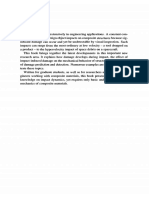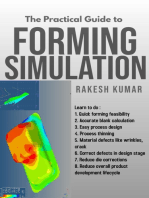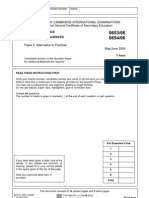Fatigue Polymers
Fatigue Polymers
Uploaded by
glihkrCopyright:
Available Formats
Fatigue Polymers
Fatigue Polymers
Uploaded by
glihkrCopyright
Available Formats
Share this document
Did you find this document useful?
Is this content inappropriate?
Copyright:
Available Formats
Fatigue Polymers
Fatigue Polymers
Uploaded by
glihkrCopyright:
Available Formats
12 Fatigue Life Estimation of Polymers
R.P.M. Janssen, L.E. Govaert, H.E.H. Meijer
Eindhoven University of Technology, Department of Mechanical Engineering
Introduction: Static Fatigue Using the plastic strain evolution in the model, this can be
Life time-estimation is imperative for reliable design of poly- solved analytically for a sawtooth signal.
mer components. Previous research showed for static fa- 3
10
tigue: cyclic stress signal
analytical solution
numerical predictions
2 Quantitative life time prediction possible, taking ther-
impact factor [−]
stress [MPa]
2
10
mal history into account. mean stress signal fails 20x faster
2 Failure governed by strain softening triggered by accu- 1
10
mulation of plastic strain. σ
ampl
= 6 MPa
80 cycle time
0
10
120 annealed
time [s]
0 2
σampl
4
[MPa]6 8 10
70
applied stress [Mpa]
true stress [MPa]
80 annealed 60 quenched Figure 3 Left: Impact of sawtooth signal on mean stress.
50
Right: Impact factor az for a sawtooth signal.
quenched
40
40
This approach yields the following impact factor for a saw-
0
0 0.25 0.5 0.75 1
30 0
10 10
2
10
4
10
time-to-failure [s]
6 8
10 tooth wave shape:
true strain [−]
Figure 1 Left: Intrinsic deformation of quenched and annealed PC. sinh(σampl /σ0 )
Right: Life time prediction of static fatigue on PC.
az =
(σampl /σ0 )
Remarkably, for this wave-shape only the stress amplitude
Impact of the Dynamic Component σampl affects the acceleration factor az . From this analytical
From cyclic fatigue experiments and simulations having a approach, it appears that frequency and mean stress do not
sawtooth-shape, it appears that (see figure 2):
play a role at all.
2 Again quantitative life time prediction is possible.
2 The dynamic component shifts the life time to lower Fatigue simulations, which are performed to validate the
values on the log(t)-axis with increasing amplitude. analytical result show that the impact factor derived from
65 65
these simulations closely matches the analytical result. Next
creep (s =0)
to a sawtooth-wave, also simulations of a sine-wave and a
d
Mean stress [MPa]
square-wave match the derived impact factor, see figure 4a.
mean stress [MPa]
60 60
constant shift
cyclic (s =4)
d
55 55
applied stress [MPa]
σ
ampl
= 0 MPa
σ (t)
σampl = 4 MPa
dyn
circles/squares = experimental σampl = 6 MPa
line = numerical prediction
50 1 50 2
10 10
2
10
3
10
4
10
5
10
3
10
4
10 σ
Time to failure [s] time to failure [s] mean
Figure 2 Left: Life time prediction of cyclic fatigue on PC. Right:
Numerical simulations indicate a shift in life time due cycle time
to the dynamic component time [s]
Based on the results from the simulation, an impact factor Figure 4 Left: Impact factor az for a sawtooth, square and sine
aimpact is defined. This relates the dynamic life time to the signal. Right: Any periodic stress signal has impact factor.
life time of the static mean stress, as follows:
tf ail,static Discussion
aimpact = It is shown that cyclic fatigue life time can be estimated from
tf ail,dynamic
the static life time. Based on the development of plastic
It is proposed that such a impact factor can also be derived strain during a cycle an impact factor was defined. Using this
from the plastic strain γ pl developed during a cycle, as de- impact factor, failure due to any periodic dynamic stress sig-
picted in figure 3a. Since numerical simulations of cyclic fa- nal (figure 4b) can be estimated from the plastic strain devel-
tigue are time-consuming, such an impact factor could save oped during a cycle. This means that time-consuming simu-
simulation time. lations can be avoided.
γpl,dynamic (tcycle )
aimpact = References:
γpl,static (tcycle )
[1] K LOMPEN , E.T.J., P H D-T HESIS , TU/ E , 2005
/department of mechanical engineering PO Box 513, 5600 MB Eindhoven, the Netherlands
You might also like
- Mechanical Add-Ons GuideDocument168 pagesMechanical Add-Ons GuidemukeshmystNo ratings yet
- A User-Material Subroutine Incorporating Single Crystal Plasticity in The Abaqus Finite Element ProgramDocument47 pagesA User-Material Subroutine Incorporating Single Crystal Plasticity in The Abaqus Finite Element ProgramangrycabbageNo ratings yet
- Conveyor Belt EquationsDocument6 pagesConveyor Belt EquationsWaris La Joi WakatobiNo ratings yet
- Fatigue Life of Rubber Components: Presented By: Abdul Hakim AbdullahDocument20 pagesFatigue Life of Rubber Components: Presented By: Abdul Hakim AbdullahSyah IlhamNo ratings yet
- COMSOL Cohesive Zone DebondingDocument22 pagesCOMSOL Cohesive Zone DebondingAaqib AliNo ratings yet
- Evaluation of Welded Cast Steel Joint Fatigue Data Using Structural Stress MethodsDocument15 pagesEvaluation of Welded Cast Steel Joint Fatigue Data Using Structural Stress MethodssscNo ratings yet
- Shape Memory AlloysDocument16 pagesShape Memory AlloysIvan HernandezNo ratings yet
- Cosmos Works FatigueDocument24 pagesCosmos Works FatigueflorinelvvNo ratings yet
- Large Deformation BeamDocument10 pagesLarge Deformation BeamAdimasu AyeleNo ratings yet
- FEM Validation HandoutDocument27 pagesFEM Validation HandoutBaljinder Singh100% (1)
- Reduced OrderDocument15 pagesReduced OrderNguyễn TrungNo ratings yet
- Nonlinear Nite Element Modeling of RC Beams Strengthened With NSM FRP RodsDocument11 pagesNonlinear Nite Element Modeling of RC Beams Strengthened With NSM FRP RodsRosNo ratings yet
- 7 Christian Gaier Multi Axial Fatigue Analysis With The Fe Post Processor Femfat Utmis 2010Document50 pages7 Christian Gaier Multi Axial Fatigue Analysis With The Fe Post Processor Femfat Utmis 2010ashish38799100% (2)
- Progressive Failure Analysis of Composite Materials Using The PucDocument87 pagesProgressive Failure Analysis of Composite Materials Using The PucMansingh YadavNo ratings yet
- Crippling Analysis of Composite Stringers PDFDocument9 pagesCrippling Analysis of Composite Stringers PDFDhimas Surya NegaraNo ratings yet
- Strength of LugDocument8 pagesStrength of LugnareniviNo ratings yet
- E 08Document16 pagesE 08João PauloNo ratings yet
- A-ANSYS 15.0 Mechanical APDL Element ReferenceDocument1,448 pagesA-ANSYS 15.0 Mechanical APDL Element ReferenceBao LamNo ratings yet
- Nonlinear Total Strain Vs Linear Strai1Document32 pagesNonlinear Total Strain Vs Linear Strai1Dasaka BrahmendraNo ratings yet
- AdvFem Meshfree 2016classDocument282 pagesAdvFem Meshfree 2016classzack100% (1)
- ETBX Stress-Life Fatigue Analysis ModuleDocument12 pagesETBX Stress-Life Fatigue Analysis ModuleArdiyan Arezel ArdhyNo ratings yet
- Analysis of Multi Layered Filament Wound Composite Pipes Under Internal PressureDocument9 pagesAnalysis of Multi Layered Filament Wound Composite Pipes Under Internal Pressurenhung_33No ratings yet
- Serge Abrate-Impact On Composite Structures (1998) PDFDocument301 pagesSerge Abrate-Impact On Composite Structures (1998) PDFShree Biradar0% (1)
- Introduction To Computational PlasticityDocument51 pagesIntroduction To Computational PlasticityLucas PrataNo ratings yet
- Damage and Failure For Ductile MetalsDocument10 pagesDamage and Failure For Ductile Metalsp_rameshreddy2006No ratings yet
- Radioss Theory Manual 12.0 Version Nov 2Document52 pagesRadioss Theory Manual 12.0 Version Nov 2M Muslem AnsariNo ratings yet
- Chapter - 8Document59 pagesChapter - 8Ankush GoelNo ratings yet
- Cohesive Zone ModelingDocument13 pagesCohesive Zone ModelingAmbalam NandhuNo ratings yet
- Imp-Thoupal 2009-Mechanics of Mechanically Fastened Joints in Polymer-Matrix Composite Structures - A Review PDFDocument29 pagesImp-Thoupal 2009-Mechanics of Mechanically Fastened Joints in Polymer-Matrix Composite Structures - A Review PDFJamalDilferozNo ratings yet
- Composite Bolted Joints Analysis Programs - Venkaya PDFDocument11 pagesComposite Bolted Joints Analysis Programs - Venkaya PDFAnonymous 1rLNlqUNo ratings yet
- Buckling and Fracture Analysis of Composite Skin-Stringer Panel Using Abaqus and VCCT 2005Document5 pagesBuckling and Fracture Analysis of Composite Skin-Stringer Panel Using Abaqus and VCCT 2005SIMULIACorpNo ratings yet
- Modeling Material Damping Properties in AnsysDocument16 pagesModeling Material Damping Properties in AnsysNono_geotec100% (1)
- Bending Strength of Gear Teeth by Cantilever-Plate TheoryDocument8 pagesBending Strength of Gear Teeth by Cantilever-Plate TheoryIsmail Ali Abdul AzizNo ratings yet
- International Journal of Fatigue: Reza Molaei, Ali FatemiDocument15 pagesInternational Journal of Fatigue: Reza Molaei, Ali FatemiJulia Pitanga CarvalhoNo ratings yet
- Dynamics of Machines - Part III - IFS PDFDocument96 pagesDynamics of Machines - Part III - IFS PDFAnonymous OFwyjaMyNo ratings yet
- Finite Element Simulation of Low Velocity Impact Damage in Composite LaminatesDocument6 pagesFinite Element Simulation of Low Velocity Impact Damage in Composite LaminatesRodrigo MaiaNo ratings yet
- ANSYS Stress LinearizationDocument15 pagesANSYS Stress LinearizationTiago CandeiasNo ratings yet
- Finite Element Simulation of Single-Lap Shear Tests Utilizing TheDocument51 pagesFinite Element Simulation of Single-Lap Shear Tests Utilizing TheLeonardo LimaNo ratings yet
- Predictive Engineering Technical Seminar - Nonlinear Analysis With SOL 106Document24 pagesPredictive Engineering Technical Seminar - Nonlinear Analysis With SOL 106Andres OspinaNo ratings yet
- Aws90 Ws Fatigue A12Document34 pagesAws90 Ws Fatigue A12faycealNo ratings yet
- NCodeDL Intro 17.0 L01 Lecture Slides Fatigue IntroductionDocument28 pagesNCodeDL Intro 17.0 L01 Lecture Slides Fatigue IntroductionscdfNo ratings yet
- Helical Spring Design - Static LoadDocument25 pagesHelical Spring Design - Static Loadjitinm007No ratings yet
- Nonlinear FEA of ElastomersDocument64 pagesNonlinear FEA of ElastomersYudhi AriadiNo ratings yet
- Failure Theories, Static LoadsDocument15 pagesFailure Theories, Static LoadsLuiz CordeiroNo ratings yet
- Strain EnergyDocument34 pagesStrain EnergyPrakhar SrivastavaNo ratings yet
- Subroutine For Cohesive ElementDocument41 pagesSubroutine For Cohesive ElementBhushanRaj100% (1)
- Damage and Failure For Ductile Metals - Abaqus PDFDocument18 pagesDamage and Failure For Ductile Metals - Abaqus PDFshayan50% (2)
- 5 Mscfatigue TutorDocument24 pages5 Mscfatigue TutorFadzrul Hisyam BadarudinNo ratings yet
- Fatigue Life Analysis of RIMS (Using FEA)Document4 pagesFatigue Life Analysis of RIMS (Using FEA)raghavgmailNo ratings yet
- 6 Composites Modelling LS-DYNA Galal-Mohamed-InDocument71 pages6 Composites Modelling LS-DYNA Galal-Mohamed-InSathi MechNo ratings yet
- Application of User Defined Subroutine U PDFDocument58 pagesApplication of User Defined Subroutine U PDFmatmean100% (2)
- Damage Mechanics in Metal Forming: Advanced Modeling and Numerical SimulationFrom EverandDamage Mechanics in Metal Forming: Advanced Modeling and Numerical SimulationRating: 4 out of 5 stars4/5 (1)
- Probabilistic Physics of Failure Approach to Reliability: Modeling, Accelerated Testing, Prognosis and Reliability AssessmentFrom EverandProbabilistic Physics of Failure Approach to Reliability: Modeling, Accelerated Testing, Prognosis and Reliability AssessmentNo ratings yet
- Fluid-Structure Interactions and Uncertainties: Ansys and Fluent ToolsFrom EverandFluid-Structure Interactions and Uncertainties: Ansys and Fluent ToolsNo ratings yet
- High Order Large Eddy Simulation for Shock-Boundary Layer Interaction Control by a Micro-ramp Vortex GeneratorFrom EverandHigh Order Large Eddy Simulation for Shock-Boundary Layer Interaction Control by a Micro-ramp Vortex GeneratorNo ratings yet
- Cyclic Plasticity of Engineering Materials: Experiments and ModelsFrom EverandCyclic Plasticity of Engineering Materials: Experiments and ModelsNo ratings yet
- Introduction to the Explicit Finite Element Method for Nonlinear Transient DynamicsFrom EverandIntroduction to the Explicit Finite Element Method for Nonlinear Transient DynamicsNo ratings yet
- Integrated Computational Materials Engineering (ICME) for Metals: Concepts and Case StudiesFrom EverandIntegrated Computational Materials Engineering (ICME) for Metals: Concepts and Case StudiesNo ratings yet
- Research Toward Use of Unprotected Steel StructuresDocument14 pagesResearch Toward Use of Unprotected Steel StructuresReaditReaditNo ratings yet
- Ball Milling - Final FinalDocument12 pagesBall Milling - Final FinalKrishna TejaNo ratings yet
- Anti Sweat HeatersDocument2 pagesAnti Sweat HeatersbreavmacNo ratings yet
- 9A01101 Engineering MechanicsDocument2 pages9A01101 Engineering Mechanicsprasaad08No ratings yet
- Titration of A Poliprotic AcidDocument7 pagesTitration of A Poliprotic AcidRaduNo ratings yet
- Design of Singly Reinforced.Document26 pagesDesign of Singly Reinforced.SAJADNo ratings yet
- 2nd Order Damping Vibrator Transfer FunctionDocument18 pages2nd Order Damping Vibrator Transfer FunctionBhakti MahbubaniNo ratings yet
- Combined Science Paper 5 Summer 05Document16 pagesCombined Science Paper 5 Summer 05igcsepapers100% (1)
- 1 s2.0 S089069550300172X Main - FlowformingDocument17 pages1 s2.0 S089069550300172X Main - FlowformingAnil JainNo ratings yet
- BCS-CRM 183 - 4 Jun2013Document2 pagesBCS-CRM 183 - 4 Jun2013Ishmael WoolooNo ratings yet
- Comparative Analysis of Different Jet Vortex Spinning Hollow Spindle Groove Structures On Yarn Mechanism and Yarn PropertiesDocument10 pagesComparative Analysis of Different Jet Vortex Spinning Hollow Spindle Groove Structures On Yarn Mechanism and Yarn PropertieshawNo ratings yet
- Klaus Christmann Adsorption 101105 PDFDocument39 pagesKlaus Christmann Adsorption 101105 PDFpallaviNo ratings yet
- 2018SU B.SC Maths SyllabusDocument18 pages2018SU B.SC Maths Syllabussachin81185No ratings yet
- Velocity & AccelarationDocument24 pagesVelocity & Accelarationryan macutoNo ratings yet
- 8 Physics ModelDocument11 pages8 Physics ModelfelcitaNo ratings yet
- Combining StressesDocument31 pagesCombining StressesYOGESH GOPALNo ratings yet
- Stresses in A Soil Mass: (Numbers Only An Example, Actual Calculated Stresses Will Be Different)Document20 pagesStresses in A Soil Mass: (Numbers Only An Example, Actual Calculated Stresses Will Be Different)Kagna SrunNo ratings yet
- Extraction of Insulin Like Compound From Bitter MelonDocument35 pagesExtraction of Insulin Like Compound From Bitter MelonNurul Hidayah Hamzah100% (1)
- Pulp ProtectionDocument4 pagesPulp ProtectionNaji Z. Arandi50% (2)
- Growth Kinetics 2014Document33 pagesGrowth Kinetics 2014Ivan Aulia BigbandNo ratings yet
- CPB 30603-Qa & QC in Chemical Engineering Task: From Your Field, Choose Any Problem and Apply QA & QC (Without Data and NoDocument5 pagesCPB 30603-Qa & QC in Chemical Engineering Task: From Your Field, Choose Any Problem and Apply QA & QC (Without Data and NoSiti Hajar MohamedNo ratings yet
- Experiment 1: Generation of Basic SignalsDocument19 pagesExperiment 1: Generation of Basic SignalsSevandhiNo ratings yet
- Type of Post and CoreDocument9 pagesType of Post and CoreErliTa TyarLieNo ratings yet
- SPECT-CT Technology and Facility DesignDocument129 pagesSPECT-CT Technology and Facility Designmladen lakic100% (1)
- Dynamic Mesh ControlDocument9 pagesDynamic Mesh Controlbinho58No ratings yet
- PhysicsDocument3 pagesPhysicsRDX CoffinNo ratings yet
- IGNOU B SC PHE09 Optics PDFDocument261 pagesIGNOU B SC PHE09 Optics PDFMadhusudan GhoshNo ratings yet
- Element Biography SheetDocument5 pagesElement Biography SheetChip ChaseNo ratings yet
- المحاضرة الثانيةDocument12 pagesالمحاضرة الثانيةEdsel Camiguing LoquillanoNo ratings yet

























































































